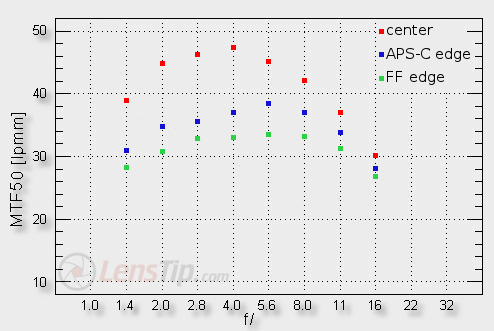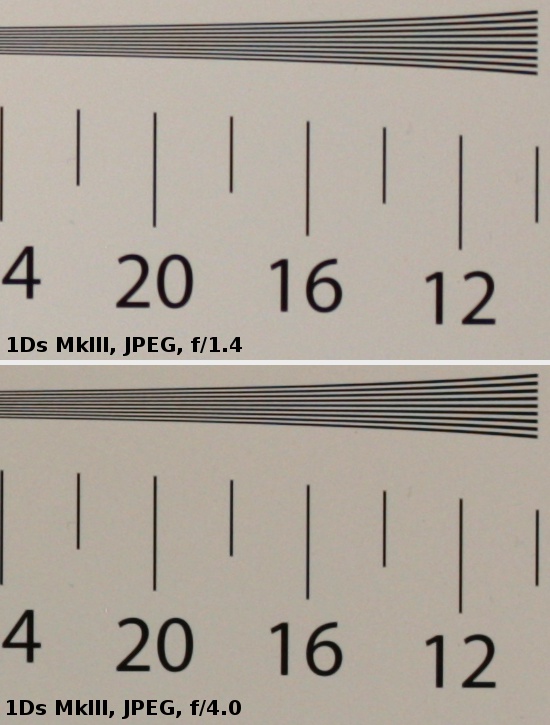Sigma A 35 mm f/1.4 DG HSM
4. Image resolution
The results of the tested Sigma are very easily comparable to the results of other 1.4/35 class lenses, tested on the Nikon D3x – it happens that the 24 Mpix sensor of the Nikon provides MTF values similar within the margin of error to the results you got on the 21 Mpix detector of the Canon 1Ds MkIII. What’s more, you can also compare it to the results of the Canon 1.4/35L, tested on the Canon 20D, with a sensor as densely packed as that of the 1Ds MkIII. The comparison to the Sony 1.4/35G is not so easy anymore because the A900 sensor, on which that lens was tested, provide a bit lower MTFs that the sensor of the Nikon D3x or the Canon 1Ds MkIII. The results of the Sony should be increased by about 10%.
Let’s check, then how the tested lens fares in the frame centre, on the edge of the APS-C/DX sensor and on the edge of full frame. A graph below will make it easier.
Please Support UsIf you enjoy our reviews and articles, and you want us to continue our work please, support our website by donating through PayPal. The funds are going to be used for paying our editorial team, renting servers, and equipping our testing studio; only that way we will be able to continue providing you interesting content for free. |
- - - - - - - - - - - - - - - - - - - - - - - - - - - - - - - - - - - - - - - - - - - - - - - -

I haven’t seen such an impressive resolution graph like that of the Sigma 1.4/35 in the frame centre for a very long time. When most of the 1.4/35 class lenses experience problems with reaching the full usefulness at the maximum relative aperture the Sigma gets to a sensational result of almost 39 lpmm. When you stop down the aperture you see really excellent values as the lens can reach 47 lpmm so practically a record-breaking level!
In order not to sound groundless let’s present the achievements of the Sigma and its rivals in one chart. Below you find the results we got, expressed in lpmm by f/1.4 and by that aperture where the lens got to the peak of its possibilities ( it means the f/4.0-5.6 range).
| |
Sigma 1.4/35 |
Zeiss 1.4/35 |
Nikkor 1.4/35G |
Canon 1.4/35L |
Sony 1.4/35G |
Samyang 1.4/35 |
| f/1.4 |
38.8 |
30.1 |
25.1 |
31.1 |
20.4 |
27.2 |
| Max |
47.4 |
47.4 |
46.3 |
44.1 |
38.4 |
44.4 |
At the maximum relative aperture and in its proximity the Sigma simply eliminates the competitors. On stopping down only the Zeiss 1.4/35 can rival its results. The chart shows it clearly who wins and who loses here. Among the losers is the Sony 1.4/35G (its results are average even if you increase their value by 10% in order to equalize the difference between different sensors, used in the tests). To justify its weak performance a bit you can add that it is an old construction, back from the times of Minolta. The Nikkor is also a loser here. It is the most expensive lens from the whole group, a new one and still, near the maximum relative aperture it can beat only the weak Sony.
The performance of the Canon and the Samyang can be only described in positive terms for a change. The first one, despite being more than a dozen years old, is doing very well while competing with much younger constructions. The Samyang, although never achieving records, can tempt you with a very affordable price. Two best instruments in this class are the Sigma and the Zeiss. What’s interesting in the resolution duel it is the cheaper Sigma which prevails.
When it comes to the resolution on the edge of the APS-C/DX sensor the situation is no longer so explicit. At the maximum relative aperture the Sigma is still better than its competitors, being a fully useful lens there and reaching a bit less than 31 lpmm. On stopping down you see the resolution level increase but it is not an especially big jump. As a result the maximum values of the Sigma are lower than those of the Zeiss and the cheap Samyang.
Similar performance can be observed on the edge of full frame. At the maximum relative aperture the Sigma doesn’t provide fully useful images but to tell you the truth it comes close and still it fares better than the competitors.
At the end of this chapter we present some crops taken from our test chart photos, saved as JPEG files (with the lowest sharpening level) along with RAW files, used for the analysis above.
 |






